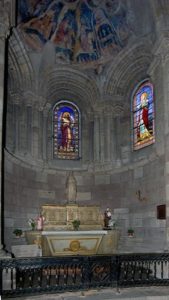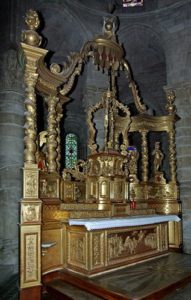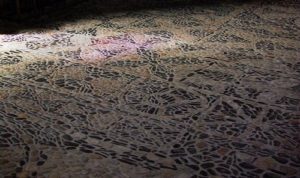In the 4thC, Julien, a Christian Roman soldier was martyred here. He was associated with the performing of miracles and pilgrims flocked to his tomb to pray. A small church was built over his tomb. In the 9thC a monastery was founded here. The present church is 11/12thC. Thie monastery was disbanded after the revolution and the church became the parish church. It was granted the status of a basilica in 1957.
Seen from the outside, it is a colourful building of pink and yellow sandstone and red scoria. It has a long nave with side aisles. Above the transept is an octagonal tower with a bright yellow and red tiled pointed roof. There is a later square tower over the west door with louvered bell flaps. The round apse at the east end has an ambulatory with five smaller apses off it. There are carved decorations below the eaves and a black and white stone design on the outside of the chancel apse.
Entry is either through the west door or the massive south porch which has pillars with carved capitals and round arches above the doorway. There are remains of frescoes above the doorway. This has huge decorative metal hinges and door knocker with an animal head which looks like a cross between hedgehog and pig.
The west end is heavily buttressed and has white stone pillars with red and white stripped arches above the doorway. There is a smaller door into the north aisle which has a decorative pattern of black and white diamonds above the door.
It is a beautiful building inside. The nave is very tall and narrow with side aisles with round arches supporting the ceiling. Red and white stone pillars support round arches. These have carved capitals with animals, heads, and foliage. The pillars continue up to form the ribs of the vaulted ceiling. Some of the pillars have the remains of frescoes. Some are abstract designs, others are scenes with people. Some of the designs are almost Egyptian like. There are glimpses of frescoes in the south gallery above the west door. The floor is covered with black and white pebbles arranged in decorative patterns.
Opposite the south door is Chapelle de la Croix. This has a black, white and grey tile floor arranged in geometric patterns. The carved wooden altar has a large retable with the crucifixion scene with the two Marys, Martha and St John. Above are cherub heads with clouds and a sunburst. On the opposite wall is a a massive wooden bench with 3 tall seats. There is a big wooden eagle book stand. On the north wall is a statue of the Virgin and Child and a modern icon of St Julian with scenes from his life round the edges.
There are three wooden doors on the north wall, one with a very elaborate carved portico round it. The huge organ is above the north aisle just before transept. The font is at the back of the north aisle. Behind it is a wooden carving of Christ holding a banner on an old host box and also an old stone sarcophagus.
The Stations of the Cross are represented by small wooden cross with a number on a diamond in the centre, mounted on a square panel.
There is a crucifix on the south wall of nave. In a glass box is a gilt and silver 14thC statue of La Vierge Parturiente propping her head on her hand. This is very rare/unusual as it shows the Virgin about to give birth. Next to her in a wall niche, is a 14thC stone carving of Vierge a l’oiseau, holding the Christ Child. According to a legend, during the flight into Egypt, the baby Jesus made model birds out of clay and blew life into them.
Large iron railings preventing entry to the chancel. The massive 17thC gilded altar has a retable with barleycorn twist pillars which support a canopy with a crown and carved drapes. Between the pillars are small statues of angels and Roman soldiers. The host box with cherubs has a crucifix surrounded by curved garlands which support a crown. There are two angels and two Roman soldiers between the pillars.
A semicircle of pillars with carved capitals and round arches separates the chancel from the ambulatory. Above are round topped stained glass windows with Biblical scenes.
The ambulatory round the back of the chancel has five chapels in the apses which are separated by round pillars with carved capitals and arches. The stained glass windows are a mix of pictures of saints and abstract patterns.
From the north side, the first apse has a bulbous wooden altar with a wooden retable with a painting with carved foliage and flowers. There are statues of Joan of Arc and St Bonite d’Alvier (with ducks) on either side of the apse.
The next apse has a wooden altar painted white with a gilt carving of the Sacre Coeur on the base. There is a low retable with gilt and blue panels and decoration. There is a statue of Joseph with the young Jesus standing beside him.
The central apse has a very decorative iron railing across it with M monograms on the gates. There is a beautifully carved wooden altar with gilt decoration and a gold cross in the centre of the base. Above is a low retable with a host box with more gilt decoration and a statue of the Virgin carrying the Christ Child above. On either side are painted angels with gilded wings holding branched metal candlesticks with flowers holding the candles. There are small statues of St Ann with the young Mary on the walls and a floor standing statue of the Virgin Mary. Between the central and the next apse to the south is a very old dark wood statue , La Sanctuan de Notre-Dame de Laurie. This is a seated Virgin in blue with a sunburst on her chest and holding the Christ Child dressed in a red robe on her lap.
The next apse to the south has an iron altar rail with a M monogram. The marble altar has gilt carvings . The small retable has the host box with panels on either side, with gilt decoration. There is a statue of St Philomena above the host box and statues of St Foy and St Antoine de Paduoe on either side.
The far right apse has a carved marble altar with two praying angels on either side of the Sacre Coeur. On either side are panels with an inlaid design with long narrow gilt panels on either side. The retable has a gold frieze along the base. The host box has a metal door and carving of the four evangelists. There is a cross on top of the host box and a large statue of Christ behind it. There are statues of St Theresa and St JB de la Salle (a cleric instructing a small boy) on the ambulatory wall next to this.
Steps lead down from the transept into the Crypt, the Sancturaire St Julien, with the tomb of St Julian beneath high altar. This has a vaulted ceiling with a metal grille protecting the sanctuary. This contains a metal relic box on a stone slab with SJ carved on the side and a modern icon of St Julien on the wall above. In a niche on the wall opposite is a crucifix.
There is a massive gallery across the west end of the church with open arches looking down on the nave and side aisles. This is reached by a spiral staircase through a small wooden door in the wall at the back of the church. We think this was only open as there was a guided tour as part of Journees-du-patrimoine.
The south gallery is covered with 13thC frescoes in shades of red, yellows and blues. These can be glimpsed from the nave below. The rest of the gallery is plaster and now bare and empty apart from an old altar under a polythene sheet.
There is a large fresco of Christ in Majesty on the ceiling surrounded by dozens of angels. In the corners are the symbols of the four evangelists. The west window has two angels, with a dove between them, trampling on a dead body. The window arch has a blue and white design with two painted figures underneath. There is a scene of Hell on the north wall with two griffin like figures breathing flames. There are paintings of vases with lilies on the bottom of the arches.
This is an amazing building. We thoroughly enjoyed our visit.










